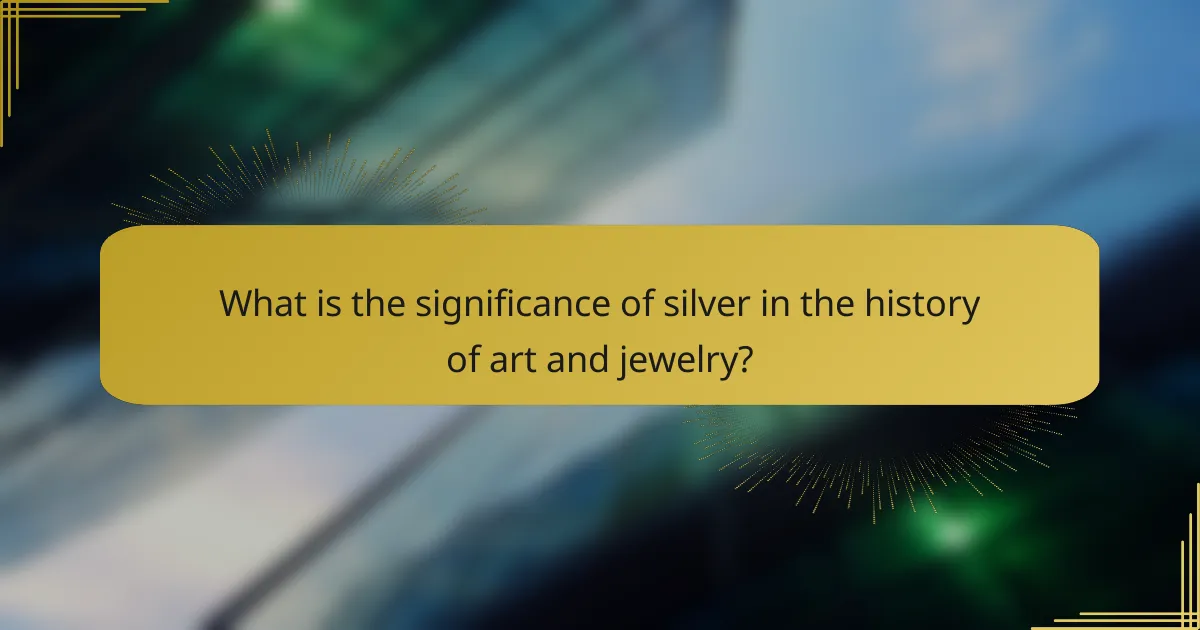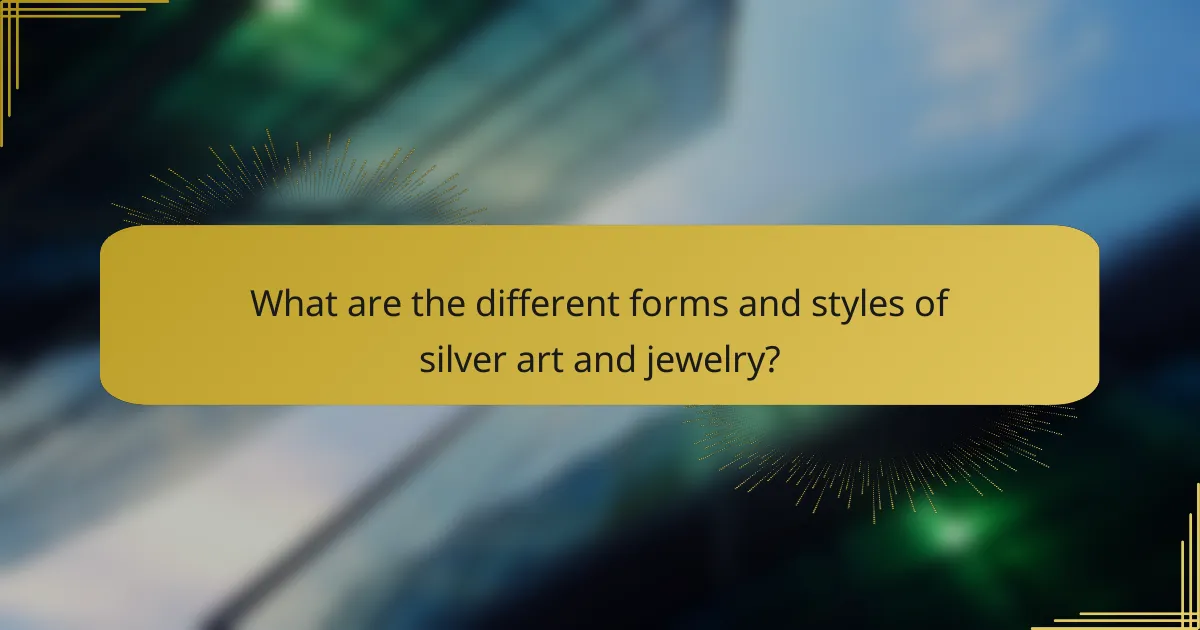Silver is a precious metal that has played a crucial role in the history of art and jewelry. Valued for its aesthetic appeal, malleability, and antimicrobial properties, silver has been utilized in various cultures for decorative, functional, and ceremonial purposes for thousands of years. The article explores silver’s historical significance, tracing its evolution from ancient civilizations, where it symbolized wealth and power, to its contemporary applications in art and jewelry. It also highlights the various forms and styles of silver art and jewelry, including silverware, decorative objects, and diverse jewelry designs that reflect cultural heritage and modern aesthetics.

What is the significance of silver in the history of art and jewelry?
Silver has been significant in the history of art and jewelry for its aesthetic appeal and malleability. It has been used for thousands of years in various cultures for decorative and functional purposes. Ancient civilizations, such as the Egyptians and Greeks, valued silver for its beauty and rarity. Silver artifacts have been found in archaeological sites, showcasing its use in jewelry, utensils, and ceremonial objects. The metal’s reflective quality made it a popular choice for mirrors and decorative items. Additionally, silver’s antimicrobial properties contributed to its use in medical instruments and containers. Its historical importance is underscored by its presence in trade and currency, influencing economies and cultures. Silver continues to be a favored material in contemporary art and jewelry, reflecting its enduring legacy.
How has silver been utilized in artistic expressions throughout different cultures?
Silver has been utilized in artistic expressions across various cultures for centuries. In ancient Egypt, silver was used to create intricate jewelry and ceremonial artifacts. The craftsmanship showcased the metal’s luster and malleability. In Mesoamerica, silver was often incorporated into religious items and decorative pieces, reflecting cultural beliefs and status. European artisans during the Renaissance utilized silver for ornate tableware and sculptures, emphasizing wealth and artistry. In Asia, particularly in India, silver filigree work became prominent in textiles and jewelry, showcasing skilled craftsmanship. Each culture’s use of silver highlights its aesthetic appeal and symbolic significance.
What are the historical uses of silver in art across various civilizations?
Silver has been used in art across various civilizations for thousands of years. In ancient Egypt, silver was often used to create jewelry and decorative items, signifying wealth and status. The Greeks utilized silver in coins and intricate sculptures, showcasing their craftsmanship. In ancient Rome, silver was employed in both functional and decorative objects, including tableware and religious artifacts. During the Middle Ages, silver became prominent in religious art, particularly in the creation of chalices and altarpieces. The Renaissance saw a resurgence of silver use in ornate jewelry and fine art, reflecting the era’s emphasis on beauty and detail. In Asia, particularly in China, silver was used for intricate carvings and ceremonial items, demonstrating cultural significance. Throughout these periods, silver’s luster and malleability made it a favored medium for artists and artisans.
How does the cultural context influence the artistic use of silver?
Cultural context significantly influences the artistic use of silver. Different cultures assign various meanings and values to silver. For instance, in many ancient civilizations, silver symbolized wealth and status. Artisans often crafted intricate designs to reflect cultural beliefs and practices. In some cultures, silver is associated with [censured] and protection. This belief drives the creation of religious artifacts and ceremonial objects. Additionally, regional availability of silver affects its artistic application. Cultures with abundant silver resources tend to produce more elaborate works. Historical events and trade routes also shape the artistic expressions involving silver. These factors create a rich tapestry of artistic styles and techniques across cultures.
Why is silver considered a valuable material in jewelry making?
Silver is considered a valuable material in jewelry making due to its aesthetic appeal and malleability. Its bright luster and reflective quality enhance the beauty of various designs. Silver is also relatively affordable compared to gold and platinum, making it accessible for a wider audience. Additionally, silver has been used in jewelry for thousands of years, establishing a historical significance. The metal’s resistance to tarnish, particularly in higher purity forms like sterling silver, adds to its desirability. Furthermore, silver is hypoallergenic, making it suitable for those with sensitive skin. Overall, these attributes contribute to silver’s enduring value in the jewelry industry.
What properties of silver contribute to its desirability in jewelry?
Silver is desirable in jewelry due to its luster, malleability, and hypoallergenic properties. The luster of silver creates a bright, shiny appearance that enhances its aesthetic appeal. Malleability allows silver to be easily shaped into intricate designs and forms, making it ideal for various jewelry styles. Additionally, silver is hypoallergenic for most people, reducing the risk of allergic reactions compared to other metals. Its durability ensures that silver jewelry can withstand daily wear while maintaining its beauty. Furthermore, silver has historical significance and cultural value, often symbolizing wealth and status throughout history.
How does silver compare to other metals used in jewelry?
Silver is more affordable and versatile than many other metals used in jewelry. It has a bright luster and is easy to work with, making it popular for intricate designs. Gold, while more expensive, offers greater durability and prestige. Platinum is rarer and denser, providing superior strength but at a higher cost. Silver tarnishes more easily than gold and platinum, requiring regular maintenance. However, it is hypoallergenic and suitable for sensitive skin. The historical significance of silver dates back thousands of years, showcasing its enduring appeal in various cultures.

How has the perception of silver evolved over the centuries?
The perception of silver has evolved significantly over the centuries. In ancient civilizations, silver was valued for its beauty and rarity. It was often used as currency and in trade, symbolizing wealth and power. During the Middle Ages, silver became associated with religious artifacts and royal regalia. This reinforced its status as a precious metal. The Renaissance period saw silver being used extensively in decorative arts and jewelry. Silver was admired for its luster and malleability. In the 19th century, silver gained popularity for everyday items, reflecting a shift towards accessibility. Today, silver is recognized not only for its aesthetic appeal but also for its industrial applications. This multifaceted perception highlights silver’s enduring significance throughout history.
What role did silver play in the economy and trade in ancient times?
Silver served as a crucial medium of exchange and a measure of wealth in ancient economies. Its rarity and malleability made it ideal for coinage and jewelry. Civilizations such as the Greeks and Romans minted silver coins, which facilitated trade across vast regions. Silver was also used in bartering, enhancing the efficiency of transactions. The value of silver fluctuated based on supply and demand, influencing economic stability. Archaeological findings indicate that silver was traded extensively along trade routes like the Silk Road. Ancient texts document its use in commerce, highlighting its significance in economic systems. Overall, silver played a vital role in shaping trade practices and wealth accumulation in ancient societies.
How did the discovery of silver deposits influence economic development?
The discovery of silver deposits significantly influenced economic development by increasing wealth and trade. Silver mining booms, such as those in Potosí, led to substantial influxes of capital. This capital facilitated the growth of local economies and trade networks. The availability of silver also impacted global trade routes, enhancing connections between continents. Increased silver production contributed to the rise of banking systems and credit. Historical records show that regions rich in silver experienced rapid urbanization and infrastructure development. For instance, cities like Zacatecas grew due to silver mining activities. Overall, the discovery of silver deposits played a crucial role in shaping economic landscapes.
What impact did silver trade routes have on cultural exchanges?
Silver trade routes significantly facilitated cultural exchanges between diverse civilizations. These routes enabled the flow of silver from the Americas to Europe and Asia. As silver moved, it also carried ideas, art forms, and technologies. For instance, the influx of silver into Europe influenced Renaissance art and architecture. Meanwhile, Asian cultures adopted European artistic techniques, enriching their own traditions. The trade routes also fostered the sharing of culinary practices and textiles. This exchange led to hybrid cultures, blending elements from different regions. Historical records indicate that cities along these routes became melting pots of cultures.
How has modern technology changed the way silver is used in art and jewelry?
Modern technology has transformed how silver is utilized in art and jewelry. Advanced tools like laser cutting and 3D printing enable intricate designs that were previously impossible. These technologies allow artists to create detailed patterns and structures with precision. Additionally, computer-aided design (CAD) software facilitates the visualization and modification of designs before production. This enhances creativity and reduces material waste during the crafting process. Moreover, modern techniques such as electroforming allow for lighter and more complex silver pieces. These innovations have expanded the possibilities for artists and jewelers, making silver more versatile in contemporary creations.
What innovative techniques are being employed in silver craftsmanship today?
Innovative techniques in silver craftsmanship today include laser engraving, 3D printing, and electroforming. Laser engraving allows for intricate designs with precision and speed. This technique enhances customization options for artisans. 3D printing enables the creation of complex shapes that traditional methods cannot achieve. It reduces material waste and production time. Electroforming allows for the creation of lightweight designs with a hollow structure. This technique provides versatility in jewelry making. Additionally, the use of CAD software streamlines the design process. These advancements reflect a blend of tradition and modern technology in silver craftsmanship.
How does contemporary design reflect historical influences of silver?
Contemporary design reflects historical influences of silver through its use of traditional techniques and motifs. Many modern artisans incorporate ancient silverworking methods, such as filigree and repoussé. These techniques date back thousands of years, showcasing the craftsmanship of cultures like the Greeks and Egyptians. Additionally, contemporary pieces often feature designs inspired by historical artifacts, merging old aesthetics with modern functionality. The revival of vintage styles can be seen in the popularity of Art Deco and Arts and Crafts movements in today’s jewelry. Furthermore, the symbolic meanings associated with silver, such as purity and wealth, continue to resonate in modern design. This connection to history enriches the narrative of contemporary silver pieces, making them not just objects but reflections of cultural heritage.

What are the different forms and styles of silver art and jewelry?
Silver art and jewelry come in various forms and styles. Common forms include silverware, decorative objects, and jewelry pieces. Silverware often features intricate designs and is used for dining. Decorative objects can range from sculptures to wall art. In jewelry, styles include contemporary, traditional, and ethnic designs. Contemporary silver jewelry often emphasizes minimalism and modern aesthetics. Traditional styles may incorporate historical motifs and craftsmanship techniques. Ethnic designs reflect cultural heritage and symbolism. Each form and style showcases silver’s versatility and appeal.
What types of silver jewelry are most popular today?
The most popular types of silver jewelry today include sterling silver rings, necklaces, bracelets, and earrings. Sterling silver rings often feature intricate designs or gemstones. Necklaces made of silver chains or pendants are also highly sought after. Silver bracelets, including bangles and cuffs, showcase both elegance and versatility. Earrings in various styles, such as studs and hoops, are favored for their classic appeal. According to a 2022 market analysis by Grand View Research, the global silver jewelry market was valued at approximately $30 billion, indicating strong consumer demand. This popularity reflects silver’s timelessness and adaptability in fashion.
How do different styles of silver jewelry cater to various fashion trends?
Different styles of silver jewelry adapt to various fashion trends by aligning with contemporary aesthetics and cultural influences. For instance, minimalist silver designs resonate with modern, clean fashion trends. These pieces often feature simple shapes and unembellished surfaces, appealing to those who favor understated elegance.
Conversely, intricate silver jewelry, adorned with gemstones or elaborate designs, caters to vintage and bohemian trends. Such styles evoke nostalgia and are often favored in festivals and artistic expressions.
Furthermore, statement silver pieces, like oversized rings or bold necklaces, align with maximalist fashion trends that emphasize individuality and self-expression. These designs often become focal points in outfits, reflecting the wearer’s personality.
Additionally, sustainable fashion trends have led to a rise in eco-friendly silver jewelry. Designers focus on recycled silver and ethical sourcing, attracting environmentally conscious consumers.
Overall, the versatility of silver allows it to be molded into various styles, making it relevant across diverse fashion movements.
What are the unique characteristics of handmade versus mass-produced silver jewelry?
Handmade silver jewelry is characterized by unique craftsmanship and individual artistry. Each piece is often created by a single artisan, allowing for personal expression and attention to detail. This results in variations in design, texture, and finish, making each item one-of-a-kind. In contrast, mass-produced silver jewelry is manufactured using industrial processes. These items are typically uniform in design and quality, with limited variation across pieces. Mass production often emphasizes efficiency and cost-effectiveness over individuality. The use of molds and machines in mass production can lead to lower quality materials and finishes compared to handmade alternatives. Handmade silver jewelry often carries a higher price point due to the labor and skill involved in its creation. Mass-produced jewelry, however, tends to be more affordable due to economies of scale.
What artistic movements have prominently featured silver?
Silver has prominently featured in various artistic movements, including Art Nouveau, Modernism, and the Arts and Crafts Movement. Art Nouveau artists utilized silver for intricate jewelry and decorative objects. Modernism embraced silver in both functional and sculptural forms. The Arts and Crafts Movement highlighted handcrafted silver items, emphasizing craftsmanship and design. Each movement showcased silver’s versatility and aesthetic appeal. For instance, Art Nouveau’s organic forms often incorporated silver into nature-inspired designs. The use of silver in these movements reflects its cultural significance and enduring allure in the art world.
How did Art Nouveau and Art Deco movements influence silver design?
Art Nouveau and Art Deco movements significantly influenced silver design through their distinctive aesthetics. Art Nouveau emphasized organic forms and intricate detailing. This movement inspired silversmiths to incorporate flowing lines and nature motifs into their designs. In contrast, Art Deco favored geometric shapes and bold colors. This led to a more streamlined and modern approach in silver pieces.
Both movements shaped the visual language of silverware and jewelry. Art Nouveau designs often featured flora and fauna, while Art Deco introduced symmetry and luxury materials. The combination of these styles created a diverse range of silver objects that appealed to contemporary tastes.
The influence of these movements is evident in iconic silver pieces from the late 19th and early 20th centuries. Designers like Georg Jensen and Tiffany & Co. embraced these styles in their work. Their creations reflect the artistic values of their time, merging functionality with artistic expression.
What contemporary artists are renowned for their silver works?
Contemporary artists renowned for their silver works include David Smith, known for his abstract sculptures. Another notable artist is Georg Jensen, who blends traditional craftsmanship with modern design. Additionally, artist and jeweler Todd Reed is recognized for his unique silver jewelry pieces. Each of these artists showcases the versatility of silver in contemporary art. Their works often reflect a combination of innovation and tradition.
What practical tips should one consider when buying silver art and jewelry?
When buying silver art and jewelry, consider the purity of the silver. Look for pieces marked with ‘925’ to ensure they contain 92.5% silver. Examine the craftsmanship to assess quality. Well-made items will have smooth finishes and secure settings for stones. Research the artist or brand for authenticity and reputation. Understanding the market value helps in making informed decisions. Check for any return policies or guarantees. This ensures you can return items if they do not meet expectations. Lastly, consider the design and personal taste to ensure satisfaction with your purchase.
How can you identify authentic silver from imitations?
To identify authentic silver from imitations, examine the metal for specific markings. Authentic silver typically has a hallmark indicating its purity, such as “925” for sterling silver. This marking signifies that the metal is 92.5% pure silver.
Next, perform a magnet test. Genuine silver is not magnetic, while many imitations contain metals that are magnetic.
Additionally, check the color and luster. Real silver has a bright, shiny appearance, while imitations may appear dull or have a different hue.
You can also conduct a nitric acid test. A drop of nitric acid on the metal will produce a creamy white reaction for genuine silver.
Lastly, consult a professional jeweler for a more accurate assessment. They can use specialized tools to determine the authenticity of the silver.
What care and maintenance practices ensure the longevity of silver items?
To ensure the longevity of silver items, regular cleaning and proper storage are essential. Cleaning silver should be done with a soft cloth to avoid scratches. Mild soap mixed with water can be used for deeper cleaning. Avoid harsh chemicals that can damage the surface. After cleaning, thoroughly dry the silver to prevent tarnishing.
Storing silver in a cool, dry place helps maintain its luster. Anti-tarnish cloths or bags can be used for additional protection. Keeping silver items away from direct sunlight and humidity is crucial. Regularly using silver items can also help prevent tarnish buildup. These practices are widely recommended by experts in metal care.
The main entity of the article is silver, focusing on its historical significance in art and jewelry. The article provides an overview of silver’s aesthetic appeal, malleability, and cultural value across various civilizations, detailing its use in ancient artifacts, jewelry, and trade. It explores the evolution of silver’s perception over time, its role in economic development, and the impact of modern technology on its artistic applications. Additionally, the article highlights different forms and styles of silver art and jewelry, contemporary trends, and practical tips for purchasing and maintaining silver items.